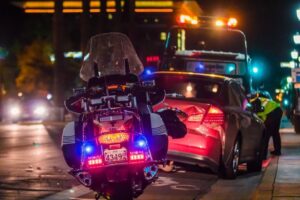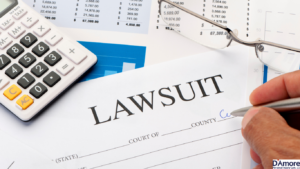
What Makes Motorcycle Accident Lawsuits Different?
Motorcycle riders have the same rights as all other road users, yet they are often overlooked or disregarded by other
D'Amore Personal Injury Law, LLC
Serious Injury Lawyers Proudly Serving
Baltimore, Annapolis, & Washington, D.C.
Summer carnivals are not always the thrilling experience families are hoping for. From May to September, approximately 20 children are treated in emergency rooms across the country every day for amusement park-related injuries, according to Nationwide Children’s Hospital. These injuries total to more than 4,000 a year, with accidents ranging from minor bumps to life threatening conditions.
Marylanders planning a trip to the amusement park over break should prepare for safety first. Familiarizing yourself with the most common amusement park dangers will allow you to spot an unsafe ride before your child boards. And taking the time to educate your children on the safety guidelines around rides could help prevent unnecessary injuries from ruining their summer.
Parents do their best to keep their kids safe at amusement parks. But not all parents are aware of the hidden risks that could put their children in harm’s way. These are three hazards parents should know before allowing their kids to ride:
Ride operators have a responsibility to keep visitors safe, although some make risky decisions that can put families in danger. In a 2018 survey released by the National Poll on Children’s Health , researchers found ride operators may be getting away with bad behaviors due to lack of reporting. Of the parents interviewed in the survey:
Unfortunately, ride operators have little supervision when on the job. These employees can get away with putting riders at risk for years if no one speaks up, increasing everyone’s risk of injury at the park.
Most amusement park and carnival accidents are completely preventable with parental supervision. However, some parents, particularly those with older children, allow their kids more independence than others.
About 1 in 5 parents admit to allowing their children between the ages of 5 and 12 to roam freely around the amusement park. Children who are unsupervised on rides may not place the same emphasis on their safety as adults. Unsupervised children and teens are more likely to participate in risky behaviors when parents are not present, including getting on rides that are too big for them, neglecting safety restraints, or getting out of control with friends.
Just because a ride is operating does not mean it’s safe. In Maryland, inflatable and carnival rides that are mobile must received a yellow and white, State of Maryland Certificate of Inspection certificate each time they move. Amusement park rides and water slides are required to be inspected annually, but these requirements do not stop some facilities from bending the rules.
Carnival rides and amusement parks in the United States are not always under strict regulation. Each state and local government is responsible for regulating amusement parks. No two states do it the same and some do not regulate rides at all. Maryland travelers who visit carnivals in states without regulations may believe they are safer on rides than they really are.
Some amusement park and carnival rides are more dangerous than others, no matter how safely you ride:
Roller coasters are made for risk takers, but they aren’t supposed to actually put riders at risk. Unfortunately, visitors who ride roller coasters can walk away from these rides dizzy, nauseous, and possibly even severely injured. Some riders experience headaches and brain injuries from banging their head backwards or side to side on over the shoulder restraints. Wooden roller coasters are even more hazardous, known for causing back and neck injuries from jolting riders around every track.
A study by Science Direct in 2012 found a strong correlation between people who ride roller coasters and brain injuries such as subdural hematoma and cereal artery dissection. Researchers found the force of the roller coaster and the excessive blood rising to the brain can lead to serious and even permanent damage under the right circumstances.
Mobile rides are non-stationary attractions workers must disassemble at the end of a carnival or traveling fair. Over the years, skepticism has risen over the safety of these rides. Some safety advocates believe taking a ride apart over and over, in addition to the damage that can happen during transport, can reduce the integrity of the ride. It’s also possible for employees who are not paying close attention during reassembly to miss a safety feature that could put riders in danger when the ride is in operation.
Water rides are one of the most dangerous amusement park rides around. The immense about of water needed to run these rides can cause malfunctions to occur that put riders at serious risk. This past May, three people were thrown from a log ride in California after the ride malfunctioned. The riders were trapped under the log and one was transported to the hospital in critical condition .
Aside from injuries, park visitors who frequent water rides can become extremely sick if swallowing the water from the ride. Water rides can become stagnant and infested with bacteria when not treated properly. One man in Pennsylvania claimed he contacted an eye-eating parasite from a water rapid ride just from being splashed in the face.
The most common amusement park injuries are also the most preventable. Nationwide Children’s Hospital reports nearly 32 percent of injuries are caused by children falling in, off, on, or against a ride. These accidents often occur if a child is not paying attention or if they are too young to be riding a ride.
Common injuries sustained from amusement park accidents include:
The remaining 20 percent of accidents are categorized as other. These can include ‘freak accidents’ and other catastrophic injuries such as amputations, brain injuries, and spinal cord damage that change someone’s life forever.
Most amusement park and carnival injuries are 100 percent preventable. By following this safety checklist created by the I.A.A.P.A, guests can significantly reduce their chances of injuries this summer:
Parents may need to take extra steps to educate their children on how to ride safely. If your child is unable to understand or comply with general safety regulations, they are not mature enough to ride. Never force a child to board a ride they are not willing to go on. Children can make unsafe decisions that could put them in serious danger.
Our Maryland accident lawyers have the trial experience to protect your rights and fight for the compensation you need and deserve. Don’t Get Mad… Get Justice! Call 1-800-JUSTICE or fill out an online contact form to get the justice you deserve. You will reach one of our successful accident attorneys to review your case. Our consultation is free, and there is no fee unless we win!
Fill out the form below and we will contact you.
Or, give us a call at

Motorcycle riders have the same rights as all other road users, yet they are often overlooked or disregarded by other

Understanding Medical Malpractice Settlements in Maryland Medical malpractice cases can be emotionally and financially devastating for victims and their families.

How Long Does It Take to Settle a Traumatic Brain Injury Case in Maryland? Traumatic brain injuries (TBIs) can have